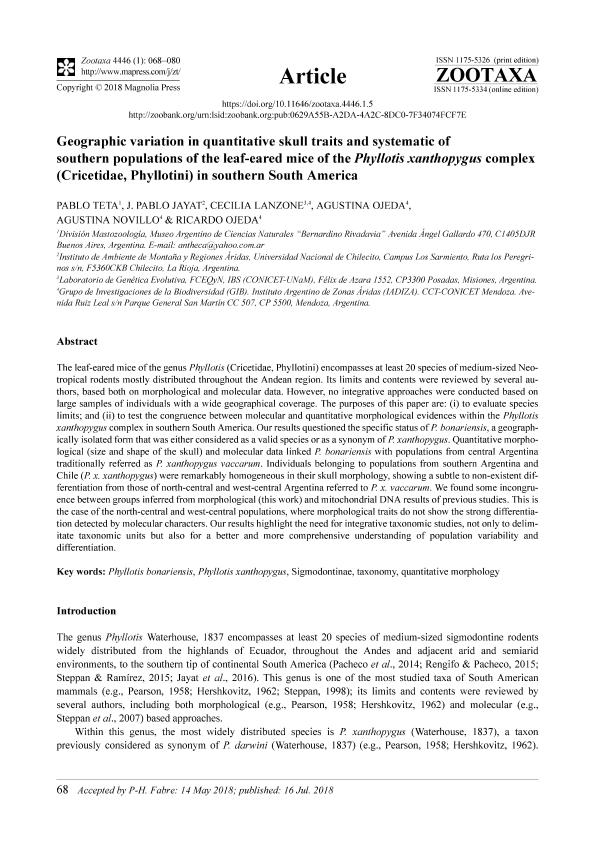Artículo
Geographic variation in quantitative skull traits and systematic of southern populations of the leaf-eared mice of the Phyllotis xanthopygus complex (Cricetidae, Phyllotini) in southern South America
Teta, Pablo Vicente ; Jayat, Jorge Pablo
; Jayat, Jorge Pablo ; Lanzone, Cecilia
; Lanzone, Cecilia ; Ojeda, Agustina Alejandra
; Ojeda, Agustina Alejandra ; Novillo, Agustina
; Novillo, Agustina ; Ojeda, Ricardo Alberto
; Ojeda, Ricardo Alberto
 ; Jayat, Jorge Pablo
; Jayat, Jorge Pablo ; Lanzone, Cecilia
; Lanzone, Cecilia ; Ojeda, Agustina Alejandra
; Ojeda, Agustina Alejandra ; Novillo, Agustina
; Novillo, Agustina ; Ojeda, Ricardo Alberto
; Ojeda, Ricardo Alberto
Fecha de publicación:
07/2018
Editorial:
Magnolia Press
Revista:
Zootaxa
ISSN:
1175-5326
Idioma:
Inglés
Tipo de recurso:
Artículo publicado
Clasificación temática:
Resumen
The leaf-eared mice of the genus Phyllotis (Cricetidae, Phyllotini) encompasses at least 20 species of medium-sized Neo- tropical rodents mostly distributed throughout the Andean region. Its limits and contents were reviewed by several au- thors, based both on morphological and molecular data. However, no integrative approaches were conducted based on large samples of individuals with a wide geographical coverage. The purposes of this paper are: (i) to evaluate species limits; and (ii) to test the congruence between molecular and quantitative morphological evidences within the Phyllotis xanthopygus complex in southern South America. Our results questioned the specific status of P. bonariensis, a geograph- ically isolated form that was either considered as a valid species or as a synonym of P. xanthopygus. Quantitative morpho- logical (size and shape of the skull) and molecular data linked P. bonariensis with populations from central Argentina traditionally referred as P. xanthopygus vaccarum. Individuals belonging to populations from southern Argentina and Chile (P. x. xanthopygus) were remarkably homogeneous in their skull morphology, showing a subtle to non-existent dif- ferentiation from those of north-central and west-central Argentina referred to P. x. vaccarum. We found some incongru- ence between groups inferred from morphological (this work) and mitochondrial DNA results of previous studies. This is the case of the north-central and west-central populations, where morphological traits do not show the strong differentia- tion detected by molecular characters. Our results highlight the need for integrative taxonomic studies, not only to delim- itate taxonomic units but also for a better and more comprehensive understanding of population variability and differentiation.
Archivos asociados
Licencia
Identificadores
Colecciones
Articulos(IADIZA)
Articulos de INST. ARG DE INVEST. DE LAS ZONAS ARIDAS
Articulos de INST. ARG DE INVEST. DE LAS ZONAS ARIDAS
Articulos(IBN)
Articulos de INSTITUTO DE BIODIVERSIDAD NEOTROPICAL
Articulos de INSTITUTO DE BIODIVERSIDAD NEOTROPICAL
Articulos(IBS)
Articulos de INSTITUTO DE BIOLOGIA SUBTROPICAL
Articulos de INSTITUTO DE BIOLOGIA SUBTROPICAL
Articulos(UEL)
Articulos de UNIDAD EJECUTORA LILLO
Articulos de UNIDAD EJECUTORA LILLO
Citación
Teta, Pablo Vicente; Jayat, Jorge Pablo; Lanzone, Cecilia; Ojeda, Agustina Alejandra; Novillo, Agustina; et al.; Geographic variation in quantitative skull traits and systematic of southern populations of the leaf-eared mice of the Phyllotis xanthopygus complex (Cricetidae, Phyllotini) in southern South America; Magnolia Press; Zootaxa; 4446; 1; 7-2018; 68-80
Compartir
Altmétricas



